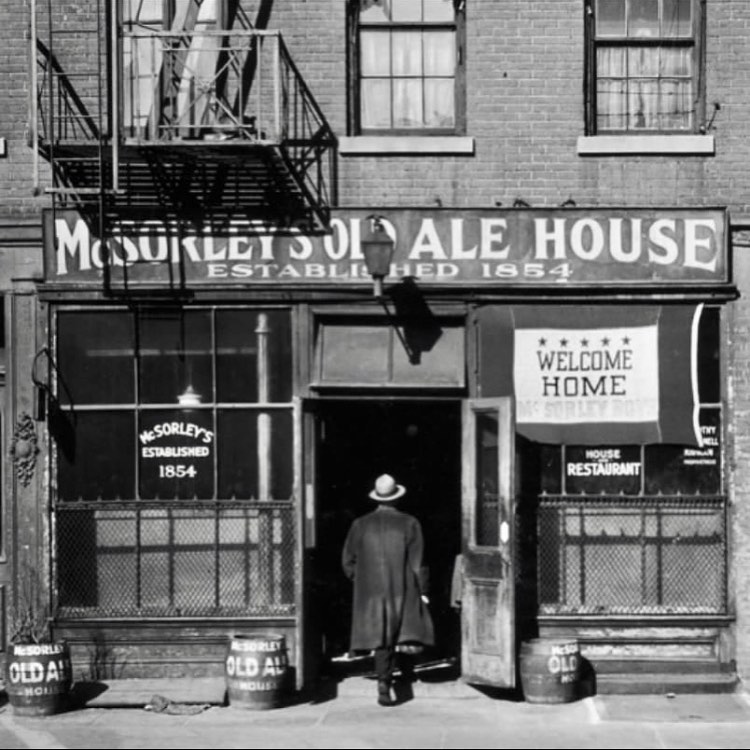McSorley’s, the venerable Irish pub, proudly holds the distinction of being the longest-standing tavern in New York City, maintaining its operations uninterrupted over the years. In 1970, a significant shift occurred as the pub opened its doors to female patrons, marking a pivotal moment.
Nevertheless, the essence of McSorley’s has persevered for well over a century and a half, virtually untouched. From the time-honored sawdust-strewn floor to the eclectic assortment of memorabilia adorning its walls (including priceless artifacts like Houdini’s handcuffs), every corner echoes with the spirit of yesteryears. Central to the experience is McSorley’s Cream Stock Ale, a signature brew available on tap, which further immerses visitors in the nostalgia of historic New York City.

The History of the most famous Irish Bar in New York City
Originating as a modest Irish working-class pub, McSorley’s journeyed from offering complimentary cheese and crackers alongside affordable beer to attaining mainstream recognition through a 1940s profile in the NEW YORKER magazine. This iconic establishment is steeped in the rich tapestry of American culture. Presidents, locals, authors, and even those of less savory intent have all congregated under its roof, all adhering to the unspoken decree of McSorley’s: “Be Good or Be Gone.” Presented here is a chronological narrative — a blend of oral tradition and visual anecdotes, a fusion of reality and whimsy.
McSorley’s Bar
1827 John McSorley, birthplace: Co. Tyrone, Ireland
1847 Onset of the Potato Blight in Southern Ireland
1850 Impact of potato crop failure spreads to Northern Counties of Ireland
1851 John McSorley arrives in New York City aboard The Colonist ship from Liverpool
1854 At 15 East 7th Street in New York City, John McSorley establishes an ale house named “The Old House at Home”
1855 Marriage of John McSorley and Honora Henley
1856 Birth of their first child, Peter McSorley
1861 Birth of William J. McSorley, John’s favored son and the future steward of McSorley’s Old Ale House
1864-65 The structure at 15 East 7th Street undergoes improvements, evolving into a five-story tenement where John and his family reside above the bar
1868 The passing of Honora McSorley leaves John to care for their three children
1872 John McSorley weds Catherine Donovan
1875 Bill McSorley, apprenticed in the art of the ale house, cultivates a deep affection for the establishment
1882 “McSorley’s Inflation,” a play featuring a bar owner named Peter McSorley, graces the Broadway stage, performing over 100 times
1888 Property ownership shifts as John and Catherine acquire the building at 15 East 7th Street
1904 The 50th anniversary celebration of The Old House at Home
1905-06 An experimental phase commences, briefly serving hard liquor alongside ale; however, McSorley’s returns to exclusively offering ale
1908 A storm-induced mishap necessitates replacing the sign with “McSorley’s Old Time Ale House,” later simplified
1910 At the age of 83, John McSorley passes away in the second-floor flat above the bar
1911 Bill McSorley assumes ownership of the ale house, converting it into a tribute to his late father
1913 John Sloan unveils his painting “McSorley’s Bar” at the Armory Show, priced at $500 but remaining unsold
1920 Prohibition takes effect, rendering various alcoholic beverages illegal; McSorley’s adapts by selling “Near Beer”
1925 Renowned poet e.e. cummings authors the poem “Sitting in McSorley’s”
1928 John Sloan captures “McSorley’s Saturday Night” in a painting, depicting patrons with mugs in hand
1932 Passing of Catherine McSorley, widow of John McSorley
1933 Prohibition concludes; McSorley’s retains its core principles despite societal shifts, embracing “Good Ale, Raw Onions, and No Ladies”
1934 Fidelio Brewery introduces bottled McSorley’s Ale, Stout & Lager Beer
1936 Bar ownership transfers from Bill McSorley to Daniel O’Connell, an NYPD officer and patron, maintaining continuity
1938 Bill McSorley passes away
1939 Ownership transitions to Daniel’s daughter, Dorothy O’Connell Kirwan; patrons speculate on potential changes, but the essence remains untouched
1940 Journalist Joseph Mitchell’s visit results in the pivotal article “The Old House at Home,” breathing new life into the aging establishment
1943 Joseph Mitchell’s articles coalesce into the book “McSorley’s Wonderful Saloon”; Life Magazine spotlights the saloon in a photographic feature
1954 McSorley’s centennial celebration, still maintaining a no-women policy, including its owner, on all days except Sundays
1960 Harry Kirwan’s son, Danny, begins his apprenticeship at the bar
1964 Chance encounter in Ireland introduces Matthew Maher to McSorley’s; he becomes a fixture, later purchasing it
1969 Legal pressure mounts for McSorley’s to admit women
1970 Under legal obligations, McSorley’s opens its doors to women, though facilities for them remain limited; predictions of its demise prove unfounded
1974 Dorothy Kirwan passes away
1975 Harry Kirwan’s death transfers ownership to his “beloved son,” Danny Kirwan
1977 Matthew Maher, night manager, purchases the establishment, marking its third ownership change
1986 Introduction of a women’s restroom at the Old House
1994 Teresa Maher de la Haba, daughter of Matthew Maher, becomes the first woman to tend the bar
Learn more about McSorley’s in this Fascinating New York City Prohibition Tour:

